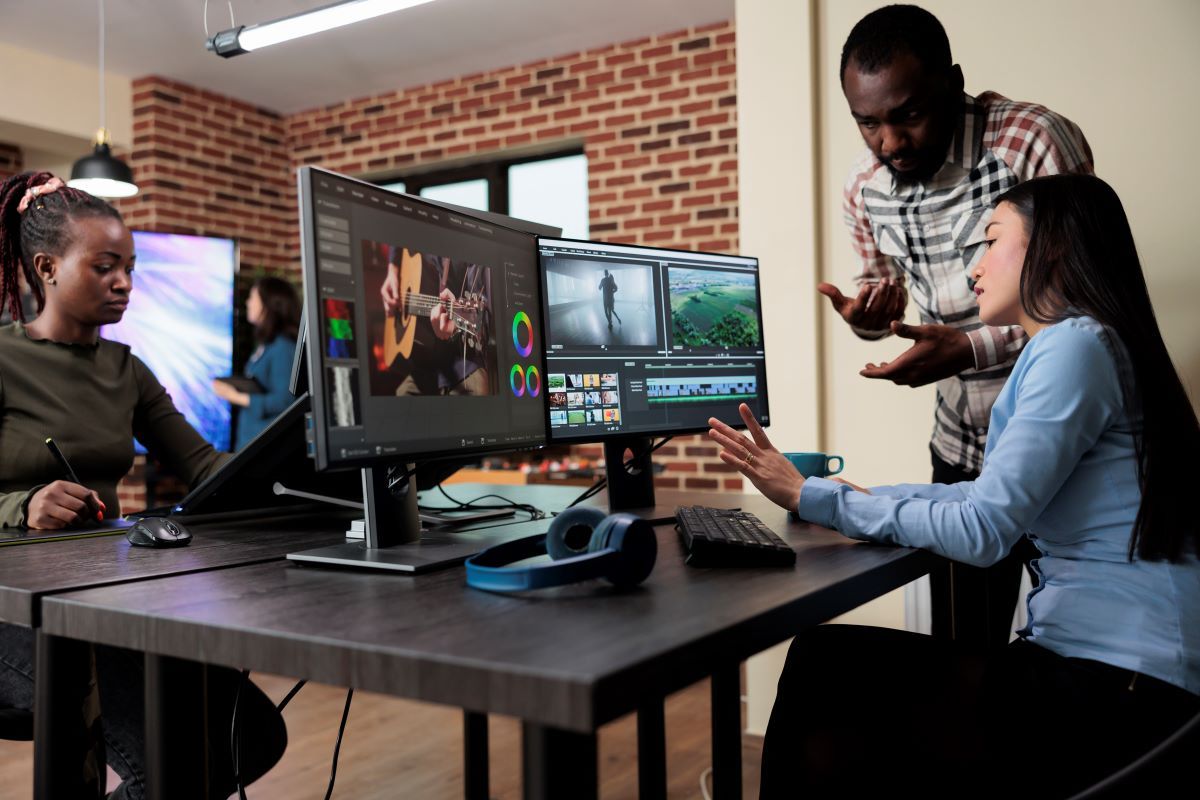Introduction
The film industry has transformed dramatically in the last decade. What once required massive in-person crews, dedicated studios, and physical editing bays can now be done from anywhere in the world. Directors, editors, and producers collaborate across continents in real time, thanks to specialized software and cloud-based tools.
But with so many platforms available, how do you choose the Best Tools for Remote Film Collaboration in 2025?
Whether you’re an indie filmmaker, documentary editor, or studio producer, having the right toolkit ensures seamless workflow, efficient communication, and creative synergy — even when your team members are thousands of miles apart.
In this guide, we’ll explore:
-
The top-rated collaboration tools for film professionals in 2025
-
How these tools compare in editing, communication, file sharing, and version control
-
Pros and cons of each platform
-
Real-world examples of production teams using them successfully

Why Remote Film Collaboration Matters More Than Ever
Before the pandemic, remote collaboration in film was rare. By 2025, it’s the industry standard.
Studios are now distributed — editors in Los Angeles, colorists in London, sound designers in Toronto, and VFX teams in Mumbai — all contributing to the same project in real time.
Key Benefits of Remote Film Collaboration
| Benefit | Description | Impact on Production |
|---|---|---|
| Flexibility | Teams work across time zones and locations | Faster turnaround, 24-hour progress cycles |
| Cost Efficiency | Reduced need for office or studio rentals | Lower production costs |
| Talent Diversity | Access to global professionals | Better creative results |
| Cloud Integration | Seamless access to project files | Easier version management |
Remote film production doesn’t just reduce logistical challenges — it opens doors to global collaboration and creative innovation that was nearly impossible a decade ago.

What to Look for in a Remote Film Collaboration Tool
To find the Best Tools for Remote Film Collaboration, it’s essential to know what makes a platform truly useful for filmmakers. Not every tool suits every role — what a director needs differs from what an editor or VFX supervisor requires.
Core Features to Prioritize
| Feature | Importance | Why It Matters |
|---|---|---|
| Real-Time Editing | Essential | Allows simultaneous adjustments without delay |
| Cloud Storage & Versioning | High | Prevents file overwrites and tracks progress |
| Frame-Accurate Review | Critical | Helps directors give feedback on specific scenes |
| Integration with NLEs | Important | Works smoothly with Premiere, DaVinci, Final Cut |
| Secure File Sharing | Must-have | Protects intellectual property |
| Cross-Platform Access | Useful | Enables use across desktop, tablet, and mobile |

The Top 10 Best Tools for Remote Film Collaboration in 2025
Below are the most effective, widely adopted, and future-ready platforms filmmakers rely on in 2025. Each one is selected based on usability, integration, scalability, and security.
1. Frame.io
Still the gold standard, Frame.io (now fully integrated into Adobe Creative Cloud) remains one of the Best Tools for Remote Film Collaboration.
It enables teams to upload, review, comment, and approve video edits in real time. The integration with Premiere Pro and After Effects makes it perfect for post-production workflows.
Key Features:
-
Time-stamped comments and drawing tools
-
Fast upload speeds with secure encryption
-
Real-time review links for clients
-
Seamless integration with Adobe products
Best For: Editors, producers, and clients reviewing post-production edits
Limitations: Pricing can be high for smaller teams, and large files may require premium storage upgrades.
2. Blackmagic Cloud
Introduced as part of DaVinci Resolve’s ecosystem, Blackmagic Cloud offers real-time collaboration inside the popular NLE software.
Team members can work simultaneously on the same project timeline, with updates syncing instantly through the cloud.
Key Features:
-
Shared project libraries
-
Built-in chat for creative feedback
-
Cloud-based Resolve project hosting
-
Affordable pricing tiers for indie filmmakers
Best For: Colorists, editors, and sound designers using DaVinci Resolve
Limitations: Less effective for non-Resolve users; requires stable internet bandwidth.
3. Wipster.io
Wipster continues to be a favorite among production houses that value client-friendly feedback loops. It offers timestamped comments, approvals, and project management in a visually intuitive interface.
Key Features:
-
Version comparison side-by-side
-
Simple UI for client reviews
-
Custom branding for agencies and studios
-
Integration with Vimeo and Adobe tools
Best For: Agencies and teams managing client-heavy workflows
Limitations: Limited advanced editing integration; better suited for review/approval than editing.
4. Evercast
Built for professional studios, Evercast combines secure live streaming, remote editing, and video conferencing in one platform.
Top Hollywood editors and directors use Evercast to collaborate on major productions — making it a staple in high-budget film environments.
Key Features:
-
Ultra-low-latency streaming for real-time feedback
-
End-to-end encryption for security
-
Multi-user streaming for remote dailies or screenings
-
Works with Avid, Premiere, and Resolve
Best For: Directors, editors, and studio-level teams needing synchronized playback
Limitations: Expensive subscription and bandwidth requirements.
5. LucidLink
LucidLink isn’t a video editor, but it’s an essential backbone for remote production teams. It creates a virtual shared drive that syncs instantly across global teams, ideal for large 4K or 8K film assets.
Key Features:
-
Real-time file streaming without downloading
-
Works with any creative software
-
Enterprise-grade data encryption
-
Cloud-agnostic storage support
Best For: Production teams with large file transfers and multi-terabyte workflows
Limitations: Requires stable internet and is less useful for smaller short-film projects.
6. ShotGrid (by Autodesk)
Previously known as Shotgun, ShotGrid has been a cornerstone in large-scale film and VFX production for years. By 2025, it remains one of the Best Tools for Remote Film Collaboration for studios managing complex workflows with hundreds of moving parts.
Key Features:
-
Advanced task and pipeline tracking
-
Real-time updates for production progress
-
Deep integration with Maya, Nuke, and other Autodesk tools
-
Version control and artist performance tracking
Best For: Large-scale productions, VFX studios, and animation teams
Limitations: Complex setup process and steep learning curve for small teams.
7. SyncSketch
SyncSketch is one of the most intuitive and creative feedback tools available today. It lets artists and directors draw directly on frames, comment on sequences, and share feedback in real time.
Key Features:
-
Frame-by-frame sketching and markup
-
Playback synchronization across users
-
Integrations with Maya, Blender, and Unreal Engine
-
Excellent browser-based performance
Best For: Animation, VFX, and motion design teams collaborating remotely
Limitations: Limited file storage; designed primarily for review, not editing.
8. Celtx
Celtx has evolved beyond a simple screenwriting app into a full-fledged pre-production powerhouse. It remains one of the Best Tools for Remote Film Collaboration for writers, producers, and directors in 2025.
Key Features:
-
Real-time script collaboration
-
Integrated budgeting and scheduling tools
-
Storyboarding and production breakdowns
-
Cloud-based team workspaces
Best For: Scriptwriters and producers managing early production stages
Limitations: Less suited for post-production or editing collaboration.
9. Notion
While not built specifically for film, Notion has become a secret weapon for remote creative teams. With templates for shot lists, production calendars, and asset libraries, it provides an all-in-one workspace for planning and documentation.
Key Features:
-
Real-time document editing and database organization
-
Integration with Google Drive and Slack
-
Task tracking, notes, and reference boards
-
Highly customizable templates for film production
Best For: Production coordinators and teams who want centralized creative organization
Limitations: Doesn’t handle media review or editing directly.
10. Slack + Zoom Combo
While not film-specific, Slack and Zoom remain indispensable for communication and quick review sessions. Slack handles daily coordination and file sharing, while Zoom offers video conferencing with high-quality screen sharing for visual discussions.
Key Features:
-
Instant messaging with searchable threads
-
Integration with Frame.io, Google Drive, and Trello
-
HD screen sharing and live collaboration calls
-
Workflow automation with custom bots
Best For: Remote teams needing constant creative communication and updates
Limitations: Not designed for file version control or heavy video review.
Comparative Table: The Best Tools for Remote Film Collaboration (2025)
| Tool | Primary Use | Ideal For | Collaboration Type | Integration Strength | Price Range (Monthly) |
|---|---|---|---|---|---|
| Frame.io | Review & Approval | Editors, Producers | Real-Time | Adobe Suite | $15–$80 |
| Blackmagic Cloud | Post-Production | Editors, Colorists | Cloud Sync | DaVinci Resolve | $5–$30 |
| Wipster.io | Client Review | Agencies, Studios | Asynchronous | Vimeo, Adobe | $25–$70 |
| Evercast | Live Streaming & Feedback | Directors, Editors | Real-Time | Avid, Resolve | $500+ |
| LucidLink | Cloud File Sharing | Production Teams | Continuous | Cross-Platform | $20–$100 |
| ShotGrid | Task Management | VFX, Studios | Team-Based | Autodesk | Custom |
| SyncSketch | Visual Feedback | Animators, VFX Artists | Real-Time | Blender, Maya | $10–$50 |
| Celtx | Script & Pre-Production | Writers, Producers | Cloud | None | $15–$60 |
| Notion | Planning & Docs | Coordinators | Asynchronous | Google, Slack | Free–$20 |
| Slack + Zoom | Communication | All Teams | Real-Time | Multiple | Free–$25 |

How AI Is Transforming Remote Film Collaboration in 2025
Artificial Intelligence has revolutionized film production workflows. Today’s Best Tools for Remote Film Collaboration are embedding AI to make creative processes faster and more seamless.
Key AI Trends
| AI Feature | Impact | Example Platform |
|---|---|---|
| Automatic Scene Tagging | AI detects and labels shots for easier search | Frame.io |
| Voice-to-Text Notes | Converts director feedback into editable text | Evercast |
| AI-Powered Editing Suggestions | Recommends shot sequences | DaVinci Resolve |
| Automated Translation | Subtitles and multilingual review support | Wipster |
| Predictive File Syncing | AI optimizes uploads and bandwidth use | LucidLink |
AI doesn’t replace human creativity — it enhances coordination and precision. From reducing time spent on repetitive editing tasks to syncing global teams automatically, it’s redefining how creative professionals work remotely.
Choosing the Right Tool for Your Team
Every filmmaker’s workflow is unique. Here’s a quick guide to selecting the most suitable platform based on your production needs:
| Team Type | Recommended Tool | Why It Works |
|---|---|---|
| Small Indie Teams | Blackmagic Cloud, Celtx, Notion | Affordable, scalable, user-friendly |
| Post-Production Studios | Frame.io, Evercast, LucidLink | Fast feedback and high-quality media handling |
| VFX/Animation Teams | ShotGrid, SyncSketch | Task tracking and frame-level review |
| Global Productions | LucidLink, Slack + Zoom | Smooth communication and data sync |
| Client-Focused Agencies | Wipster.io, Frame.io | Clean review interface with client approval tools |

What makes a collaboration tool ideal for film production?
The best tools enable real-time editing, version tracking, and time-coded feedback. Cloud integration and security are essential for teams handling large video assets and confidential projects.
Which collaboration tool works best with DaVinci Resolve?
Blackmagic Cloud is designed for seamless integration with DaVinci Resolve, allowing multiple users to edit the same timeline simultaneously.
Can AI replace editors in remote film collaboration?
Not entirely. While AI improves efficiency by automating repetitive tasks like tagging or color matching, human editors still make the creative decisions that define the film’s narrative.
What is the most cost-effective remote film collaboration tool?
For small teams or indie filmmakers, Celtx and Notion offer the best balance of features and affordability.
How secure are cloud-based film collaboration platforms?
Leading platforms like Frame.io and Evercast use end-to-end encryption and enterprise-level security protocols. For more details, refer to this Forbes Tech article on cloud collaboration security.


Leave a comment